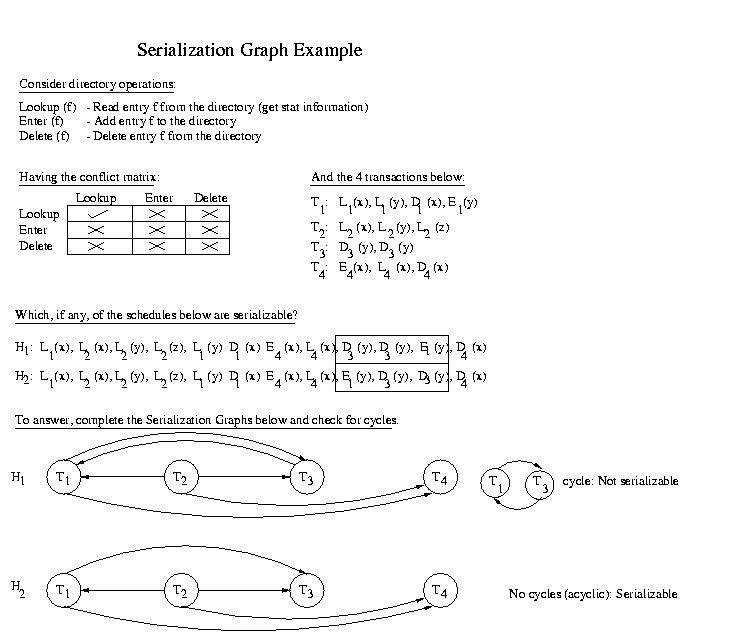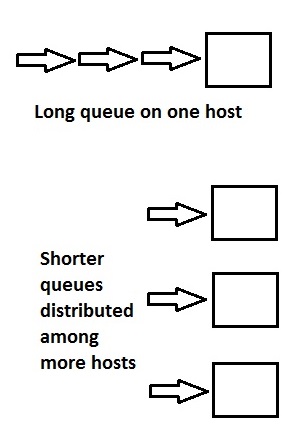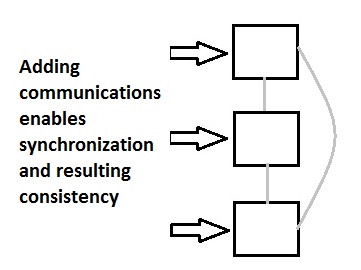Return to lecture notes index
June 5, 2014 (Lecture 9)
Safe Schedules
Last class we discussed the "Isolation" propoerty of transactions.
Transactions must execute as if in isolation. That doesn't
necessarily prohibit concurrency among transactions -- it just
implies that this concurrency shouldn't have any effect on the
results or the state of the system. In fact, as long as the results
and other state are the same as for some serial execution of the
transactions, the transactions can be interleaved, executed concurrently,
or btoh.
Transaction processing systems (TPSs) contain a
transaction scheduler that dispatches the transactions and
allows them to execute. This scheduler isn't necessarily FIFO,
and it doesn't necessarily dispatch only one at a time. Instead,
it tries to maximize the amount of work that gets done. One
popular measure of the performance of a TPS is the number of
transactions per second (TPS). Yes, unfortuantely, TPS
is also its abbreviation.
In discussing the scheduler, it is helpful to ask the question,
"What is a schedule?" It is an ordering of events. The transaction
scheduler's job is to execute the indivdual operations that compose
the transactions in an order that is efficient and preserves the property
of isolation. As a result, it is the schedule of individual operations
that is our concern.
Safe Concurrency: Serial Schedules and Serializability
A serial schedule is a schedule that executes all of the operations
from one transaction, before moving on to the operations of another
transaction. In other words the transactions are executed in series.
An interleaved schedule is a schedule in which the operations
of an individual transaction are executed in order with respect to the
same transaction, but without the restriction that the transactions
be scheduled as a whole. In other words, interleaving allows the scheduling
of any operation, as long as the operations of the same transaction are
not reversed.
Some interleaved schedules are safe, whereas other way result in violations
of the isolation property. Safe interleaved schedules are known as
serializable schedules. This is because an interleaved schedule is
only safe if it is equivalent to a serial schedule -- that's why
they call it serial-izable.
What did I mean when I wrote, is equivalent? An interleaved
schedule is equivalent to a serial schedule, if transactions which
containing conflicting operations are not interleaved. Operations are
said to be conflicting if the results differ depending on their
order.
This means that an interleaved schedule is serializable if, and only if,
each pair of operations occurs in the same order as they would in
some serial schedule.
Serializability Graphs
We can see if a schedule is serializable by building a serialzability
graph. The Fundamental Theorem of Serializability states
that a schedule H is serializable, if and only if, SG(H) is acyclic.
So how do we build a serializability graph?
- Create a node for each transaction
- Draw an edge from Ti to Tj if and only if
some operation in Ti conflicts with an operation in
Tj and the operation in Ti occurs before
the operation in Tj in the given schedule. The example
belwo will make this a bit clearer.
Example: Directory Operations

Let's take a careful look and make sure that we understand the source of
the problem in schedule H1. The fragment below shows only
the relevant portion of the schedule:
. . . L1(x) . . . L1(y)
. . . D3(y) . . . D3(y)
. . . E1(y) . . .
If we look at the fragment, we see that L1(x) conflicts
with D3(y). Since L1(x) occurs before
D3(y) in H1, an equivalent serial schedule
must execute T1 before T3. But if we look further
ahead in the trace we see that D3(y) occurs before
E1(y). Similarly, since these operations conflict, it
implies that T3 must occur before T1 in an
equivalent serial schedule. Both of these statments cannot be true.
If T1 executes before T3, T3 cannot
execute before T1. This schedule cannot be converted to an
equivalent serial schedule. It is not serializable -- it is not safe.
Two-Phase Locking
Transaction, by their nature, play with many different, independent
resources. It is easy to imagine that, in our quest for a high
throughput, we process two transactions in parallel that share
resources.
This can generate an obvious problem for "Isolation". We need to ensure
that the results are consistent with the two (or more) concurrent transactions
being commited in some order. So we can't allow them to make uncoordinated
use of the resources.
So, let's asusme that, while any transaction is writing to a resource, it
is locked, preventing any other transaction from writing to it. Now,
a transaction can acquire all of the locks it needs, complete the mutation,
and release the locks. This scheme prevents the corruption of the resources
-- but opens us up to another problem: deadlock.
Let's imagine that one transaction wants to access resource A, then C, then
B. And, other concurrent transaction wants to access resource B, then A, then
C. We've got a problem if the one of the transactions grabs resources A and
C, and the other grabs resources B. Neither transaction can complete. One is
hold A and C, waiting for the other to release B. And, the other is holding
B, while waiting for C and A. What we have here is known as circular
wait, which is one of the four "necessary and sufficient" conditions
for deadlock, usually captured as:
- Non-sharable resource, e.g. mutual exclusion
- Non-preemptable (no police, or even big sticks, to settle disputes)
- Hold and wait usage (holding a resource while needing another)
- Circular wait (hold and wait + a circular dependency chain)
Fortunately, circular-wait is often very easy to attack. If the resources
are enumerated in a consistent way across users, e.g. A, B, C, D, ...Z,
and each user requests resources only in increasing order (without
wrap-around), circular wait is not possible. One can't wait on a lower
resource than one already holds, so the depednency chain can't be
circular.
This observation is the basis of a two-phase lock. In the first phase,
a transaction acquires -all- of the locks it needs in strictly -increasing-
order. It then uses the resources. In the last phase, it shrinks,
or releases locks. This universal ordering in which all users acquire
resources prevents deadlock.
In practice, transactions often are said to begin phase-1 (growing) when
they start and end phase-1 when they are done processing and are ready to
commit. Phase-2 begins (and ends) upon the commit. So, the essential
part of 2PL is, as you might guess, the serial order in which the locks
are acquired. The two phases are, in practice, mostly imaginary.
Locking and Serializability
Let's think again about 2-Phase Locking (2PL). Although it is handled by
the transaction manager, it does allow for the interleaving of operations.
Are the schedules that it generates serializable?
The answer to this is yes. Two-phase locking ensures that transactions
which use the same objects cannot execute concurrently. This ensures
that no conflicts can happen. If interleaved transactions don't share, we
know that we are safe.
Two phase locking ensured serialzable schedules using what is known as
inconsistency prevention. Prevention techniques constrain the
transactions to ensure that conflicting operations can never happen.
Two-phase locking does this by preventing transactions that share
objects from executing concurrently. Although inconsistency prevention
is effective, it is also expensive. Perfectly safe sharing may be
prevented -- this unnecessarily reduces concurrency.
The CAP/Brewer Conjecture
It is commonly desirable for distributed systems to exhbit
Consistency, Availability, and Partition tolerance.
- By consistency we mean that all participating systems share
the same view of the data. For example, if one system observes the
value five, all systems would, if they looked, observe the value
five at that time. None, for example, would be more stale or more
fresh than others.
- By Availability we mean that the system is able to respond
quickly enough for the user's needs. For example, if a Web page
times out, or users abort before seeing the results, it is not
available.
- By Partition tolerance we mean that, in the event of the
failure or isolation of some participants, the other participants
can continue to do whatever they can. For example, the loss of
certain nodes might necessitate disconnecting certain clients or
the inability to return certain results -- but should not unduely
interfere with the ability of the functioning nodes to service
clients and/or return results.
The CAP Conjecture, attributable to Eric Brewer of UC-B, is that
we can build systems that guarantee up to two of these properties -- but
not necessarily all three. Let's consider why.
Imagine a system with too much of a queue. We can fix that by adding
more systems and dividing the work as seen below:

The picture above is nice, because we have availability. And, in
the event of a partitioning, the reachable nodes can still respond, so we
have partition tolerance. The problem, though, is that we've lost
consistency. Each host is operating independently, so the values can
diverge if updates differ. This is the "AP"/"PA" case.
To add back consistency, we'll need to have communications among the hosts
such that they can sync values:

But, notice what has happened. We gained consistency through communication.
If we break that communication, we're back where we started. So, we now
have consistency and availability, but not also partition tolerance. This
is the "CA"/"AC" case.
What about the "PC"/"CP" case? How can we have consistency and
partition tolerance without availability, at least in any
meaningful way? One ansewer, which is I think a good example, is that we
enable reads, but not updates. Now we have sacraficed the avaialability
of writes in order to ensure maintaining consistency in light of a
partitioning.
Note: You'll often see what I've called the "CAP Conjecture"
described as the "CAP Theorem". I do not believe this to be correct.
The conjecture, is, I think, important because it allows us to
frame the trade-offs we're likely to see in real world systems. Attempts
to "prove" the conjecture into a theorem have introduced constraints and
formalisms that, I think, separate it from the generally applicable
cases. As it turns out, there is a natural tension at work here: One
can only prove something that is defined, but fuzzy edges makes things
more applicable and gives them a broader reach.
BASE: One More Acronym
You'll occasionally hear or read of the acronym BASE. It stands for:
- Basically available means that small failures don't
generate large disabilities. It is the same idea as what we call
"soft failure" vs "hard failure", but with the added emphasis that
a few failures in a large scale system shouldn't really be noticable.
- Soft state is usually intended to convey state that can be
generated or refreshed upon demand, rather than necessarily being
stored as "hard state". But, in this case, it is being used to
convey that values, even after written, will continue to change
without any explicit user request. Specifically, they'll propagate
out slowly.
- Eventual consistency conveys the idea that, although
the system might be inconsistent for some time after an update,
it will eventually converge to consistency. Without this property,
or an approximation thereof, what good would the system be?
BASE is often contrasted with ACID. The idea being that
traditional ACID semantics are very pessimistic and do a lot
of work, assuming that any inconsistency would be noticed and result in
disaster. BASE, by contrast, is vry optimistic and assumes
that the inconsistencies are unlikely to result in disaster before they
are eventually fixed.
In class, I gave the example of the "quantity avaialble" a store
displays for an item via its online catalog and shopping cart. If you are
buying one or two items, does it matter if they tell you 450 or 452 are
available? In this case, a slightly slate value doesn't matter, right?
When does it matter -- when you check out. If they take your money, you'd
better have your goods. Have you ever went to check out and gotten an
error, "Ooops. Your items sold!". Did it really just sell, that very
moment? Or, had it been sold the whole time? You don't know. What you do
know is that it doesn't matter -- you can't have it. This is a case where
most lookups can be a little stale -- and, only at the very end, do we
need the "correct" answer.
The idea that we can trade off correctness for time, effort, and
availability is a good one, as is the observation that favoring complete
correctness and consistency at any cost, may be an unnecssary extreme --
depending upon the application.
ACID vs BASE, get it? But, I think the acronym is strained. :-)


